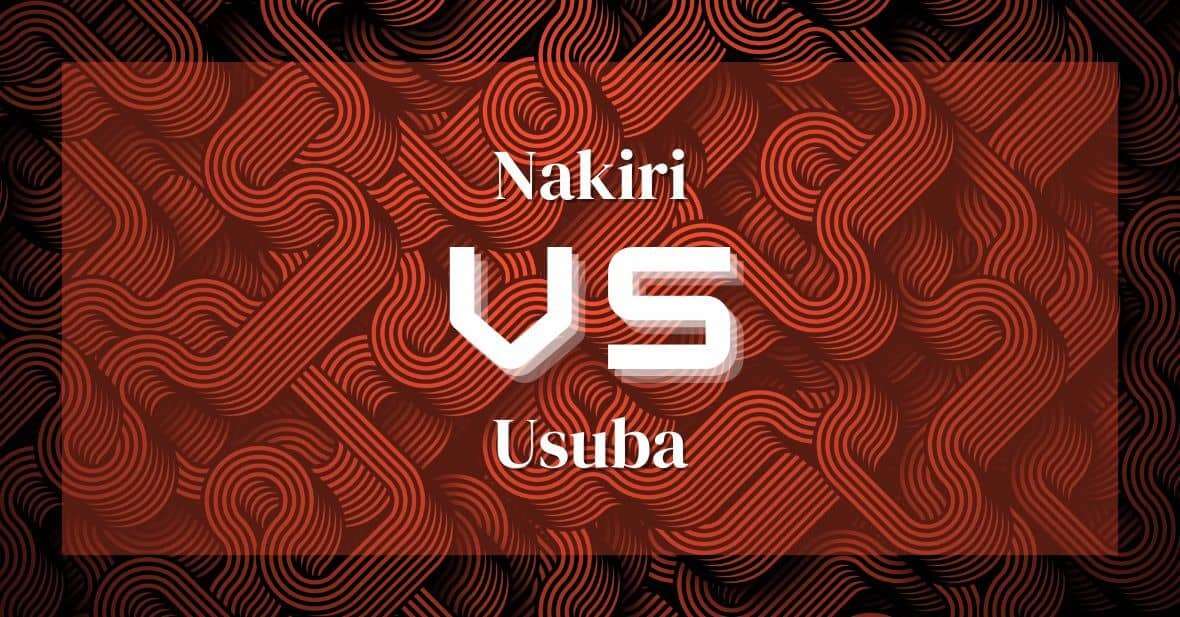Nakiri Vs Usuba: Unveiling the Perfect Vegetable Knife
One of the most important decisions a chef can make is choosing the right knife for their kitchen. And when it comes to Japanese-style knives, there’s no better duo than the nakiri and usuba.
These two blades are like night and day but they both bring something unique to any kitchen. It’s up to you to decide which one will be perfect for your needs. So get ready to explore the fascinating world of nakiri vs usuba!
It’s like a classic battle between two heavyweights: nakiri with its sharp, straight edges; and usuba with its curved blade that makes it ideal for precision cutting. Both knives have distinct shapes that make them suitable for different tasks in the kitchen – so if you want an all-rounder, you can’t go wrong with one of these beauties!
Just remember that whatever choice you make, it’ll become your trusted companion in all those cooking adventures ahead!
Overview of Nakiri Knives
Cutting vegetables has never been easier than with a nakiri knife, making it an essential tool for any aspiring chef. It’s the perfect combination of form and function that makes it so desirable.
The great thing about nakiri knives is that they have a straight blade with two flat edges that make them ideal for slicing through vegetables quickly and efficiently. Additionally, because their blades are thinner than other types of knives such as Santoku or Gyuto, they don’t tend to crush or bruise delicate produce.
For those looking for something more aesthetically pleasing, there are also nakiri knives made from Damascus steel which offer beautiful patterns in addition to their superior cutting performance.
Overview of Usuba Knives
You’ll be slicing and dicing like a pro with an usuba knife. Its thin blade makes it perfect for precision cutting. An usuba is a traditional Japanese vegetable knife that comes in two sizes: Ko-Usuba (small) and O-Usuba (large). Its single beveled edge allows you to cut vegetables into extremely thin slices. Plus, the straight edge of the blade makes it great for grinding techniques and sharpening methods.
Here are three things you need to know about using an usuba knife:
- It’s lightweight – At just over 6 ounces, this knife won’t tire out your arm while you chop up veggies!
- It’s durable – Usuba knives are made from high carbon steel, so they’re built to last.
- It’s sharp – With proper care and maintenance, these knives will stay razor sharp for years to come!
So if you’re looking for a reliable tool for precision cutting, look no further than the classic usuba knife. Get ready to have some serious fun in the kitchen!
Differences in Blade Shape
Get ready to master the art of precision cutting with the usuba knife’s unique blade shape!
The usuba is made from a single piece of steel and has a wider and thinner blade than a nakiri. This grinding technique gives it an incredibly sharp edge that can slice through vegetables like butter.
It also features an angled tip which allows for more control in your cutting style. With some practice, you’ll be able to create perfect produce slices with ease.
Not only does this make prepping meals easier, but it also adds a bit of showmanship to your culinary skills!
Differences in Uses
No matter your cutting needs, the usuba and nakiri knives offer different uses to help you get the job done. The usuba knife is perfect for preparing vegetables with its thin blade and sharp edge. It’s also great for cutting fish as its shape allows it to easily maneuver around bones.
On the other hand, the nakiri knife is specially designed to make short work of veggie prep with its wide blade that cuts through produce like butter! Whether you’re looking to prepare a vegetable medley or fillet some fish, these two knives have got you covered.
Choosing the Right Knife for Your Kitchen
When it comes to kitchen knives, there’s no need to choose between the two – both the usuba and nakiri can help you get the job done! Whether you’re prepping a salad or slicing up vegetables for a stir fry, these two types of Japanese knives have you covered.
And don’t worry if you’re not an experienced knife-wielder; with their rectangular shape and single beveled edge, using either one is easier than cutting with a traditional chef’s knife. Plus, they look great in any kitchen setup!
With their sharp blades and classic design, usuba and nakiri knives will help take your cooking skills to the next level – without breaking the bank.
Conclusion
It’s time to decide which knife is right for you.
Nakiri knives are great for chopping vegetables, while usuba knives are ideal for more delicate work. Which one is the best fit? Ultimately, it depends on what you need from your knife and how comfortable you feel with each type of blade shape.
The only way to truly know is by trying them both out! With a little practice and patience, you can find the perfect knife that works perfectly for all your needs.
Frequently Asked Questions
What Is The Best Way To Care For A Nakiri Or Usuba Knife?
Caring for a nakiri or usuba knife is essential if you want to keep it in top shape. To get the most out of your knife, you’ll need to pay attention to sharpening techniques, cutting boards, and storage options.
Sharpening can extend the life of your blade and help maintain its sharpness. Opting for a quality cutting board is also important; avoid glass or other hard surfaces that can damage the blade’s edge.
Lastly, store your knife safely away from any other objects when not in use to prevent accidental cuts or dulling of the blade’s edge. With these tips in mind, you’ll have a reliable kitchen companion that will last for years!
Are There Any Special Techniques For Using A Nakiri Or Usuba Knife?
You might be surprised to learn that a nakiri or usuba knife is the go-to tool for many professional chefs. When using these types of knives, there are some special techniques you’ll want to employ.
First and foremost, make sure your knife is sharpened properly. This will ensure clean cuts each time and reduce the risk of injury. You’ll also want to use a cutting board made of soft wood, such as bamboo, which will prevent any accidental dulling of the blade’s edge.
Finally, practice makes perfect, so don’t be afraid to get creative with your cutting techniques! Who knows – maybe you’ll even come up with something new!
What Type Of Handle Material Is Best For A Nakiri Or Usuba Knife?
When it comes to choosing the best handle material for a nakiri or usuba knife, you have plenty of options. From traditional wood handles to modern synthetic materials, there’s something for everyone.
If you’re looking for a classic look and feel, then wood is the way to go. It’s comfortable in your hand and provides excellent grip when sharpening tips or storing solutions. Plus, it adds a touch of humor with its rustic charm!
On the other hand, if you prefer something more modern and durable, then synthetic materials are the way to go. They provide superior grip and won’t wear down over time like wood can.
So, no matter what type of handle material you choose, make sure it fits your needs and style!
Is A Nakiri Or Usuba Knife The Best Choice For A Beginner Cook?
If you’re a beginner cook, you might be overwhelmed by all the choices of knives. But don’t worry – neither a nakiri nor usuba knife is the wrong choice.
Both are great for beginners because they’re relatively easy to maintain and sharpen. Plus, they both have a wide blade, which makes it easier to chop vegetables quickly and evenly.
The only difference between them is that the nakiri has a flat edge while the usuba has a slightly curved one. So if you want something that looks cool in your kitchen but also provides excellent performance, either one would make an excellent choice!
What Is The Average Price Range For A Quality Nakiri Or Usuba Knife?
When it comes to finding the perfect knife for all your cooking needs, you’ll want to consider both a nakiri and an usuba.
Both types of knives are designed for chopping vegetables, but they come with different price tags. Quality nakiri and usuba knives can range anywhere from $50-$200 depending on the brand, material, and size.
To get the most out of your purchase, be sure to look into knife maintenance tips and cooking advice from professional chefs.
Once you have the right blade in hand, you’ll be able to slice through veggies like a pro!
Additional Resources
19 Types of Kitchen Knives & Their Uses
Western Style Knives 101 | A Comprehensive Introduction to the Basics
The Art of the Slice: A Dive into Japanese Knife Types
What Is a Nakiri Knife Used For? Unlock the Secret to Flawless Vegetable Prep
Forging Culinary Excellence: The Best Steel For Kitchen Knives

